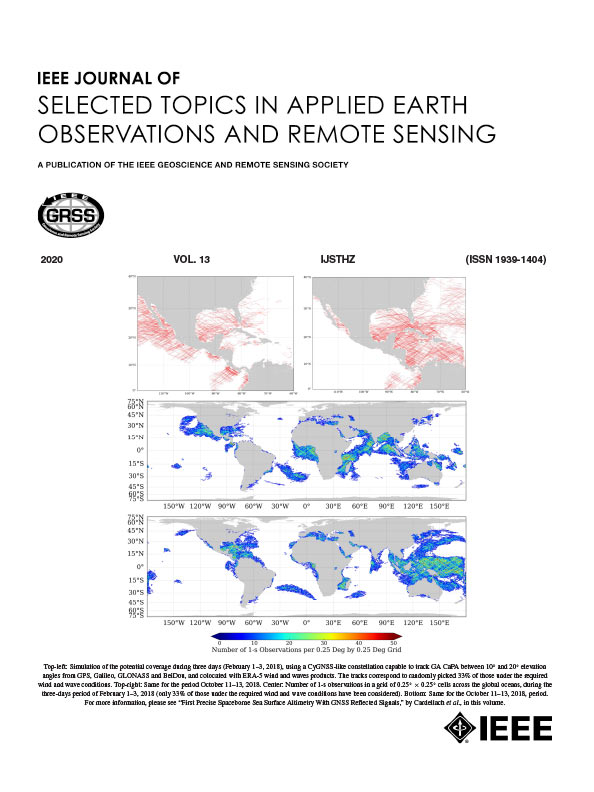X-band Repeat-pass Coherence at Short Temporal Baselines for Crop Monitoring
IF 4.7
2区 地球科学
Q1 ENGINEERING, ELECTRICAL & ELECTRONIC
IEEE Journal of Selected Topics in Applied Earth Observations and Remote Sensing
Pub Date : 2025-03-27
DOI:10.1109/JSTARS.2025.3555382
引用次数: 0
Abstract
A one-year time series of X-band images acquired by TerraSAR-X (TSX), TanDEM-X (TDX), and PAZ in the same orbit configuration over an agricultural area has been exploited to assess the potential of X-band repeat-pass coherence for crop monitoring. The combination of TSX, TDX, and PAZ allows working with temporal baselines of 4 and 7 days, i.e., shorter than the 11-day revisit time of the individual satellites. These short temporal baselines are less affected by temporal decorrelation and help increase the sensitivity of coherence to crop growth. The analysis is carried out for 30 different crop types by comparing series of coherence and backscatter at X-band with normalized difference vegetation index (NDVI) extracted from Sentinel-2. C-band coherence from Sentinel-1 is also analyzed with the same dataset for comparison purposes. In addition, a new radar vegetation index for copolar data, called copolar radar vegetation index (coRVI), is defined and evaluated. During the phenological cycle of the crops, coherence decreases at the early stages, and it increases again after harvest, keeping high values out of the growing season. X-band coherences for baselines of 4 and 7 days show the strongest correlations with NDVI, especially for short crops. Regarding the use of coRVI, it outperforms the backscattering coefficient of individual channels. Moreover, coRVI is better correlated with NDVI than coherence for several crop types, hence providing complementary information. The main conclusion is that X-band repeat-pass coherence with short temporal baselines (4 or 7 days) could be a valuable tool for crop monitoring if an adequate acquisition plan were implemented routinely.用于作物监测的短时基线 X 波段重复通相干技术
利用TerraSAR-X (TSX)、TanDEM-X (TDX)和PAZ在农业地区相同轨道配置下获得的一年时间序列x波段图像,评估x波段重复通过一致性用于作物监测的潜力。TSX、TDX和PAZ的组合允许使用4天和7天的时间基线,即比单个卫星11天的重访时间短。这些短时间基线受时间去相关的影响较小,有助于提高一致性对作物生长的敏感性。利用Sentinel-2遥感影像提取的植被归一化差异指数(NDVI),对30种不同作物类型的x波段相干和后向散射序列进行分析。为了进行比较,还对Sentinel-1的c波段相干性进行了分析。此外,定义并评价了一种新的共极雷达植被指数,即共极雷达植被指数(coRVI)。在作物物候周期中,一致性在早期降低,收获后再次增加,在生长季节之外保持高值。4天和7天基线的x波段相干性与NDVI的相关性最强,尤其是短茬作物。在使用coRVI时,它优于单个通道的后向散射系数。此外,对于几种作物类型,coRVI与NDVI的相关性优于相干性,因此提供了互补信息。主要结论是,如果常规实施适当的采集计划,具有短时间基线(4或7天)的x波段重复通过一致性可以成为作物监测的有价值工具。
本文章由计算机程序翻译,如有差异,请以英文原文为准。
求助全文
约1分钟内获得全文
求助全文
来源期刊
CiteScore
9.30
自引率
10.90%
发文量
563
审稿时长
4.7 months
期刊介绍:
The IEEE Journal of Selected Topics in Applied Earth Observations and Remote Sensing addresses the growing field of applications in Earth observations and remote sensing, and also provides a venue for the rapidly expanding special issues that are being sponsored by the IEEE Geosciences and Remote Sensing Society. The journal draws upon the experience of the highly successful “IEEE Transactions on Geoscience and Remote Sensing” and provide a complementary medium for the wide range of topics in applied earth observations. The ‘Applications’ areas encompasses the societal benefit areas of the Global Earth Observations Systems of Systems (GEOSS) program. Through deliberations over two years, ministers from 50 countries agreed to identify nine areas where Earth observation could positively impact the quality of life and health of their respective countries. Some of these are areas not traditionally addressed in the IEEE context. These include biodiversity, health and climate. Yet it is the skill sets of IEEE members, in areas such as observations, communications, computers, signal processing, standards and ocean engineering, that form the technical underpinnings of GEOSS. Thus, the Journal attracts a broad range of interests that serves both present members in new ways and expands the IEEE visibility into new areas.

 求助内容:
求助内容: 应助结果提醒方式:
应助结果提醒方式:


